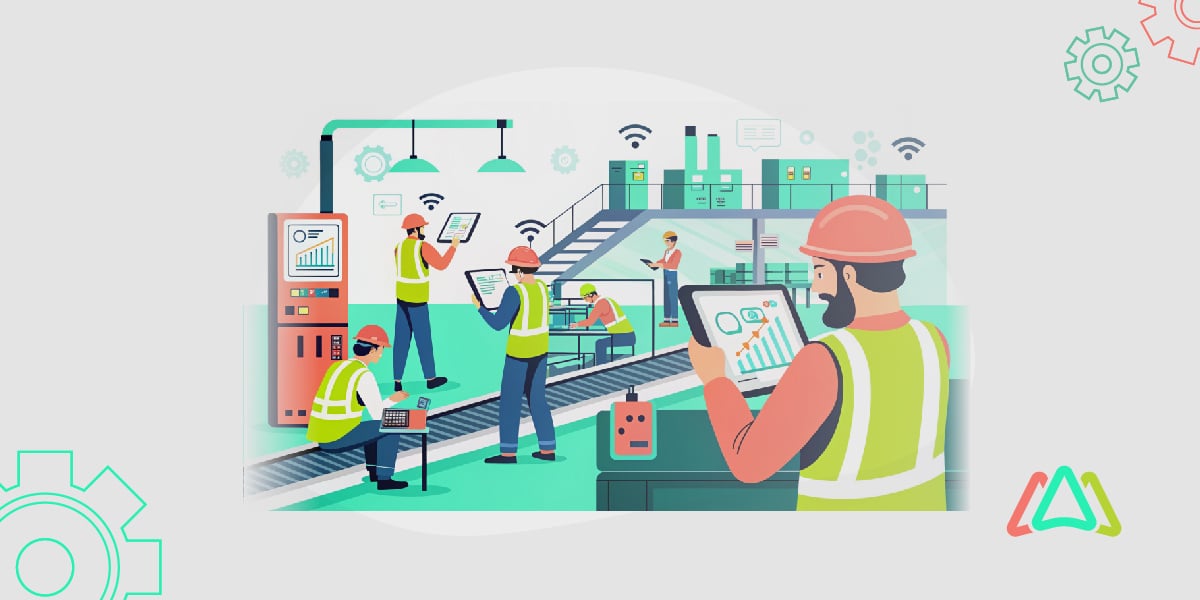
Transforming Maintenance Management with CMMS and IOT Integration
In today’s business world, where every second counts and downtime can mean disaster, efficient maintenance management has become key to successful operations. Yet, many organizations still struggle with outdated systems that lead to unexpected breakdowns, increasing costs, and operational inefficiencies.
Imagine a world where your maintenance system doesn’t just react to problems but predicts them before they occur. Computerized Maintenance Management Systems (CMMS) and the Internet of Things (IoT) are the pioneering spirit of this revolution. CMMS streamlines maintenance processes, while IoT introduces real-time monitoring, transforming inert equipment into smart, self-reporting assets.
Together, these technologies are rewriting the rules of asset management, turning maintenance into a proactive, data-driven strategy. They don’t just enhance efficiency—they redefine it. From predictive maintenance to seamless automation, CMMS and IoT integration offer organizations the tools to cut costs, maximize uptime, and gain a competitive edge.
The future of maintenance is here. Let’s dive into how this powerful combination is shaping the modern business landscape.
What is CMMS?
A Computerized Maintenance Management System (CMMS Software) is designed to centralize, organize, and optimize maintenance operations. It serves as a digital hub that streamlines work order management, schedules preventive maintenance, tracks asset performance, and ensures the availability of critical inventory.
At its core, a CMMS enables maintenance teams to execute the following operations easily:
Schedule and Track Tasks
This is a primary CMMS feature. Automating maintenance schedules and tracking work orders in real time are critical for minimizing equipment downtime and ensuring smooth workflows.
Manage Assets
Asset management is another core feature. Maintaining detailed records of assets, such as service history, warranties, and performance data, helps businesses improve asset reliability, extend life cycles, and plan for replacements or upgrades.
Optimize Inventory
Inventory management is an essential function in CMMS software, particularly for industries reliant on timely access to spare parts and supplies. Optimizing stock levels prevents delays and ensures efficient maintenance operations.
Generate Reports
Reporting and analytics are critical for data-driven decision-making. These reports offer insights into maintenance costs, resource allocation, and performance, enabling companies to improve operations.
Workforce Management
Assigning tasks to technicians based on skills, availability, or location ensures the right person is handling the right job. This improves workforce efficiency and reduces time wasted on improper task assignments.
Preventive Maintenance Planning
A CMMS ensures that equipment is serviced before breakdowns occur, minimizing downtime and extending asset longevity. Preventive maintenance reduces emergency repairs and associated costs.
Regulatory Compliance
Documenting maintenance activities is critical for meeting legal, safety, and industry standards. A CMMS simplifies the process of maintaining audit trails, ensuring organizations remain compliant and prepared for inspections.
What is IoT?
The Internet of Things (IoT) refers to a network of interconnected devices that use sensors and internet connectivity to collect, share, and analyze data in real time. These "smart" devices enable seamless communication between physical objects, users, and systems, transforming how we interact with technology in daily life and industries.
IoT has evolved significantly since its inception in the 1990s, when computer scientist Kevin Ashton coined the term. Early implementations focused on connecting a few devices, but today, billions of devices, ranging from home appliances to industrial machinery, are part of this ever-growing network.
IoT can be categorized into three main types:
Consumer IoT
Consumer IoT encompasses devices and technologies designed for personal and home use, aimed at improving convenience, health, and lifestyle. These include smart home devices like voice-controlled assistants (e.g., Alexa or Google Home), smart thermostats, and automated lighting systems. Wearable devices, such as fitness trackers and smartwatches, provide users with real-time health data, including heart rate monitoring, step tracking, and sleep analysis. Personal medical tools like connected blood pressure monitors or glucose meters enable individuals to manage their health more effectively and stay connected with healthcare providers.
Industrial IoT (IIoT)
Industrial IoT drives innovation in sectors such as manufacturing, energy management, transportation, and space engineering. In these industries, IoT plays a key role in enabling real-time monitoring of spacecraft and satellites, automating operations, and supporting predictive maintenance. Other applications include smart factories with interconnected machinery and energy grids that optimize resource consumption. IIoT focuses on improving efficiency, reducing downtime, and driving innovation in highly technical fields.
Commercial IoT
Commercial IoT focuses on improving business operations across industries like healthcare, retail, and logistics. In healthcare, it supports innovations such as remote patient monitoring, smart hospital beds, and connected diagnostic equipment. In retail, IoT-enabled systems like smart shelves, beacons, and automated checkout systems enhance customer experiences and streamline inventory management. Businesses also use IoT for smart security systems, climate control, and supply chain optimization, ensuring seamless operations and better customer satisfaction.
By connecting devices and enabling real-time data sharing, IoT drives innovation, improves efficiency, and creates smarter solutions for various industries and everyday life.
How IoT Enhances Maintenance Management with CMMS
The integration of IoT (Internet of Things) with CMMS revolutionizes maintenance management by providing real-time insights, predictive capabilities, and enhanced operational efficiency. Here’s how IoT takes CMMS to the next level:
Real-Time Asset Monitoring
IoT sensors enable continuous tracking of asset performance by monitoring key parameters such as temperature, vibration, energy consumption, and pressure. This data is sent directly to the CMMS for real-time insights. This empowers maintenance teams to proactively address minor issues before they escalate, preventing costly breakdowns, reducing unplanned downtime, and extending equipment life spans.
Predictive Maintenance
IoT-driven CMMS leverages historical and real-time data to identify patterns and predict potential failures, enabling maintenance teams to schedule repairs at optimal times. This approach reduces emergency repair costs, minimizes equipment damage, and enhances operational efficiency by ensuring equipment reliability, boosting productivity, and improving asset utilization.
Inventory Management
IoT sensors enable real-time tracking of inventory levels, automating supply chain processes by triggering automatic replenishment orders when spare parts reach a minimum threshold. This minimizes downtime by ensuring critical parts are readily available for repairs while optimizing stock levels, helping businesses reduce carrying costs and avoid overstocking.
Work Order Automation
IoT-triggered alerts automate the generation and assignment of work orders by detecting abnormal equipment behavior, creating a work order in the CMMS, and notifying the appropriate technician. Maintenance teams receive real-time alerts, enabling prompt issue resolution. Additionally, automating work order assignments eliminates manual processes, ensuring efficient deployment of the right resources.
Safety and Compliance
IoT sensors are essential for monitoring hazardous conditions like gas leaks, temperature spikes, or structural vibrations. They provide real-time alerts that enhance safety by preventing accidents and protecting workers. Additionally, IoT integration ensures regulatory compliance by maintaining detailed audit trails and documentation, helping businesses adhere to safety standards effectively.
By combining IoT capabilities with CMMS, organizations can transition from reactive to proactive maintenance strategies, reduce costs, and create safer, more efficient work environments. This powerful integration transforms maintenance management into a data-driven, future-ready process.
Benefits of CMMS and IoT Integration
The integration of CMMS and IoT delivers transformative benefits for businesses, combining data-driven insights with streamlined maintenance processes. Here’s a summary of the key advantages:
Increased Productivity
IoT sensors provide real-time data, feeding directly into the CMMS to streamline maintenance workflows. Automated work orders and predictive alerts reduce delays, helping technicians prioritize and resolve issues faster and improving overall efficiency.
Cost Savings
With predictive maintenance powered by IoT, organizations can avoid expensive emergency repairs and unplanned downtime. Optimized inventory management reduces overstocking and carrying costs while extending asset life minimizes capital expenditures on replacements.
Enhanced Safety
IoT sensors monitor hazardous conditions, such as gas leaks or overheating equipment, triggering immediate alerts. This ensures worker safety by preventing accidents and maintaining compliance with safety regulations through detailed audit trails.
Improved Decision-Making
The combination of IoT data and CMMS analytics provides actionable insights into asset performance, maintenance trends, and resource allocation. These insights empower businesses to make informed decisions, optimize processes, and plan long-term maintenance strategies.
Better Resource Utilization
Automated inventory replenishment, efficient work order management, and predictive scheduling reduce time, labor, and materials waste. Maintenance teams can then focus on high-priority tasks, maximizing their impact.
By leveraging the synergy between CMMS and IoT, organizations can drive operational excellence, reduce costs, and create safer, smarter, and more sustainable maintenance ecosystems.
Conclusion
The integration of IoT with CMMS is revolutionizing the way businesses manage maintenance operations. With real-time asset monitoring, predictive maintenance, and streamlined workflows, organizations can increase productivity, reduce costs, enhance safety, and make data-driven decisions for long-term success. By adopting IoT-enabled CMMS, businesses can unlock the full potential of their assets and maintenance operations, ensuring reliability, reducing downtime, and optimizing resources.
TABLE OF CONTENTS
Keep Reading
Ever find yourself checking into a luxury hotel and expecting a relaxing stay, only to find a ...
11 Apr 2025
Organizations are witnessing swift changes in the business environment and confronting a ...
8 Apr 2025
Last month, news outlets and the entire internet was abuzz with the return of NASA astronauts ...
3 Apr 2025
What comes first - CMMS or predictive maintenance? If your answer is either, it is correct. ...
28 Mar 2025
Artificial intelligence (AI) talk has become commonplace. Today, engaging in business-focused ...
27 Mar 2025
Imagine a world where machines predict, diagnose, and fix their issues before they fail. This ...
25 Mar 2025
A facility maintenance plan is at the core of a facility’s operations. This organized ...
21 Mar 2025
Think of managing your maintenance operations like managing a championship sports team. Just ...
21 Mar 2025
The maintenance sector is battling a severe talent shortage that threatens to undermine ...
7 Mar 2025
Manufacturing maintenance is the backbone of industrial efficiency, ensuring machines run ...
5 Mar 2025
No one likes playing a guessing game when equipment breaks down. Yet, maintenance teams often ...
4 Mar 2025
The size of the preventive maintenance software market is discussed in millions of dollars, ...
4 Mar 2025
The organizational structure and corporate hierarchy vary from company to company. Large ...
28 Feb 2025
Maintenance procedures are essential for ensuring the longevity and reliability of machinery ...
21 Feb 2025
Sustainability is no longer just a buzzword; it's a critical component of corporate social ...
20 Feb 2025
A Computerized Maintenance Management System (CMMS) relies on accurate, well-organized data ...
18 Feb 2025
In an era where technology drives operational efficiency, Computerized Maintenance Management ...
14 Feb 2025
A Computerized Maintenance Management System (CMMS) is a key component of modern maintenance ...
13 Feb 2025
Introduction Maintenance management is the foundation of maintenance operations in industries ...
11 Feb 2025
Introduction A Computerized Maintenance Management System (CMMS) is software designed to help ...
7 Feb 2025







